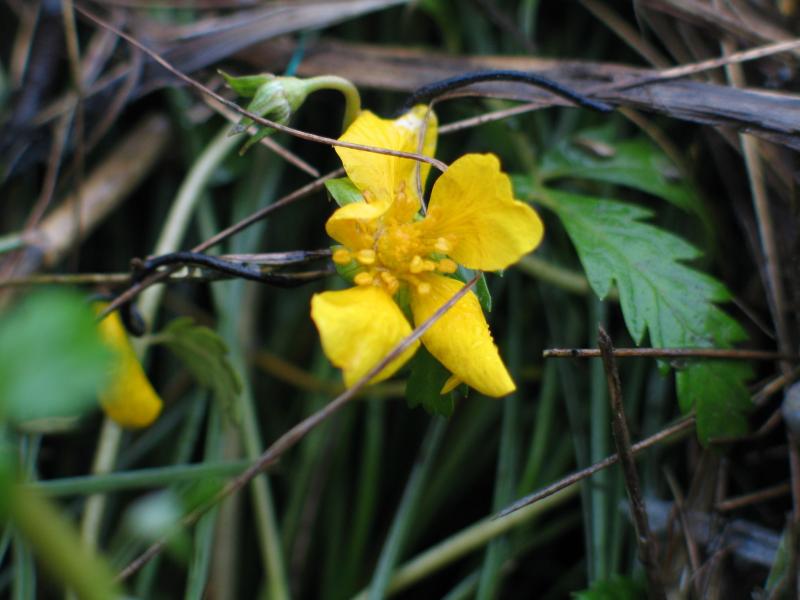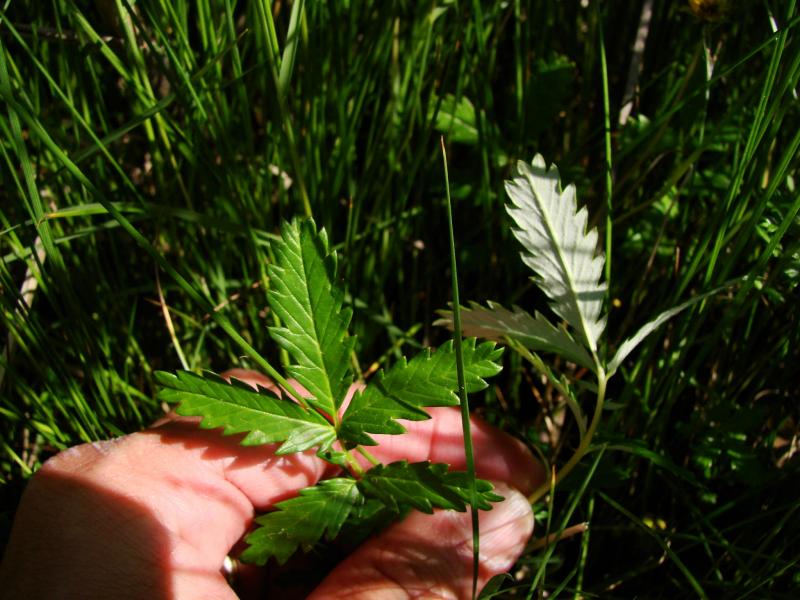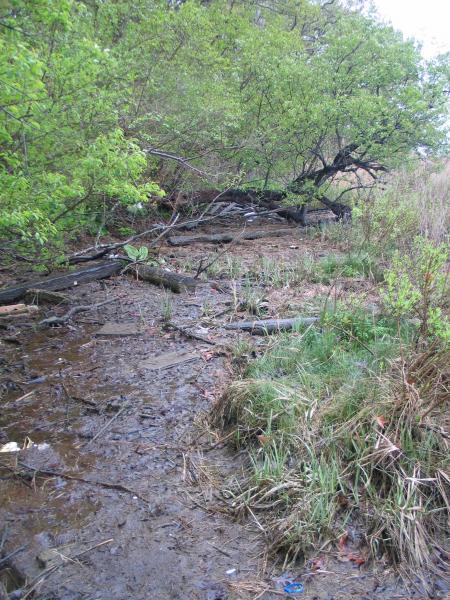Coastal Silverweed
Potentilla anserina ssp. pacifica (T.J. Howell) Rousi
- Class
- Dicotyledoneae (Dicots)
- Family
- Rosaceae (Rose Family)
- State Protection
- Threatened
Listed as Threatened by New York State: likely to become Endangered in the foreseeable future. For animals, taking, importation, transportation, or possession is prohibited, except under license or permit. For plants, removal or damage without the consent of the landowner is prohibited.
- Federal Protection
- Not Listed
- State Conservation Status Rank
- S2
Imperiled in New York - Very vulnerable to disappearing from New York due to rarity or other factors; typically 6 to 20 populations or locations in New York, very few individuals, very restricted range, few remaining acres (or miles of stream), and/or steep declines.
- Global Conservation Status Rank
- G5T5
Secure globally - Both the species as a whole and the subspecies/variety are common in the world; widespread and abundant (but may be rare in some parts of its range).
Summary
Did you know?
Argentina comes from the Latin word for silver. It refers to the silvery hairs that cover the leaves of the species.The country of Argentina derives its name from the silver that was shipped down the silver river (Rio de la Plata) from the Potosi silver mines in Bolivia (Wikipedia contributors).
State Ranking Justification
There are 10 existing populations and most of them are of good to excellent quality. There are 10 historical populations.
Short-term Trends
There is not enough recent information to evaluate short-term trends.
Long-term Trends
There are about as many existing populations as they were historical populations so species has remained stable over time. Future trends may be downward as Phragmites populations expand.
Conservation and Management
Threats
This plant occurs in salt marshes often invaded by Phragmites.
Conservation Strategies and Management Practices
Control Phragmites invasions in the salt marshes where it exists and prevent new incursions. Natural buffers should be established around the salt marshes to decrease pollution runoff and other direct human disturbances.
Research Needs
Habitat studies should be performed to discover why plants prefer some salt marshes over others and why they may be distributed in only a small portion of the marsh.
Habitat
Habitat
In New York, coastal silverweed is known from coastal wetlands including salt marshes, brackish tidal marshes, and the shores of coastal salt ponds (New York Natural Heritage Program 2010). Wet, sandy seacoasts, commonly in brackish soil (Gleason and Cronquist 1991).
Associated Ecological Communities
- Brackish intertidal shore
A community of the intertidal gravelly or rocky shores of brackish tidal rivers and creeks where water salinity ranges from 0.5 to 18.0 ppt.
- Brackish tidal marsh
(guide)
A marsh community that occurs where water salinity ranges from 0.5 to 18.0 ppt, and water is less than 2 m (6 ft) deep at high tide. The vegetation in a brackish tidal marsh is dense and dominated by tall grass-like plants.
- Coastal plain pond shore*
(guide)
The gently sloping shore of a coastal plain pond with seasonally and annually fluctuating water levels. Plants growing on the pond shore vary with water levels. In dry years when water levels are low there is often a dense growth of annual sedges, grasses, and herbs. Submerged and floating-leaved aquatic plants, such as fragrant waterlily and pondweeds, may become "stranded" on the exposed shore. In wet years when the water level is high only a few emergents and floating-leaved aquatics may be noticeable. T
- Coastal salt pond
(guide)
A community inhabiting marine shoreline lakes or ponds formed by sandspits that close off a lagoon or bay. The water typically averages brackish or slightly brackish over long periods of time, but may range rapidly from fresh to saline.
- High salt marsh
(guide)
A coastal marsh community that occurs in sheltered areas of the seacoast, in a zone extending from mean high tide up to the limit of spring tides. It is periodically flooded by spring tides and flood tides. High salt marshes typically consist of a mosaic of patches that are mostly dominated by a single graminoid species.
* probable association but not confirmed.
Associated Species
- Agalinis maritima
- Agrostis stolonifera (creeping bent)
- Amaranthus cannabinus (salt marsh water-hemp)
- Atriplex prostrata (seaside orach)
- Baccharis halimifolia (groundsel-tree)
- Bolboschoenus robustus (sea-coast bulrush)
- Carex silicea (beach sedge)
- Distichlis spicata (salt grass)
- Eleocharis
- Gaylussacia baccata (black huckleberry)
- Iva frutescens (salt marsh-elder)
- Juncus gerardii
- Lilaeopsis chinensis (eastern grasswort)
- Limonium carolinianum (sea-lavender)
- Limosella australis (Atlantic mudwort)
- Myrica pensylvanica
- Phragmites australis ssp. australis
- Plantago rugelii (Rugel's plantain)
- Pluchea odorata (salt marsh-fleabane)
- Polygonum glaucum (sea-beach knotweed)
- Quercus alba (white oak)
- Salicornia depressa (slender glasswort)
- Schoenoplectus americanus (chair-maker's bulrush)
- Schoenoplectus pungens
- Smilax rotundifolia (common greenbrier)
- Spartina alterniflora (smooth cord grass)
- Spartina patens (salt-meadow cord grass)
- Suaeda
- Symphyotrichum tenuifolium
- Triglochin maritima (sea arrow-grass)
Range
New York State Distribution
This salt marsh plant occurs on the eastern end of Long Island with a few historical records on the western end that are now considered extirpated.
Global Distribution
This is an arctic species of northern Canada and Alaska that extends down the east coast of the US from Maine to Long Island.
Identification Comments
General Description
Coastal silverweed is a creeping perennial herb species. It spreads by long stolons which root at the nodes, producing new leafy stems. The leaves are pinnately compound, with leaflets up to 4 cm long with long, sharp teeth and undersides covered with dense silvery tomentose hairs. The stolons, pedicels, and axes of the leaves are covered with long, silky hairs. The flowers are 1.5 to 2.5 cm across, with 5 yellow petals, and are solitary on erect pedicels from the leaf axils or the nodes of the stolons. The fruits are clusters of achenes 1.5 to 2.0 mm long and flattened laterally (Gleason and Cronquist 1991, Haines 1998).
Best Life Stage for Proper Identification
Coastal Silverweed is best determined when in fruit, but flowering or vegetative specimens may also be identified.
Similar Species
Argentina egedii ssp. groenlandica is closely related to Argentina anserina. A. anserina differs by having the undersides of the leaves covered with long silky hairs (covering up the short gray-silvery tomentose hairs) and achenes about equally as thick as wide and deeply grooved on one side, while A. edgedii ssp. groenlandica has silky hairs on the veins only (underside of the leaves still tomentose) and flattened achenes rounded or with a shallow groove (Gleason and Cronquist 1991).
A. egedii ssp. groenlandica is the only subspecies in New York. Potentilla argentea (Silvery Cinquefoil) is a related species which also has leaves silvery tomentose on the underside, but its leaves are palmately compound.
Best Time to See
Coastal Silverweed flowers from mid-June to mid-August and fruits during August and September.
- Flowering
- Fruiting
The time of year you would expect to find Coastal Silverweed flowering and fruiting in New York.
Coastal Silverweed Images
Taxonomy
Coastal Silverweed
Potentilla anserina ssp. pacifica (T.J. Howell) Rousi
- Kingdom Plantae
- Phylum Anthophyta
- Class Dicotyledoneae
(Dicots)
- Order Rosales
- Family Rosaceae (Rose Family)
- Order Rosales
- Class Dicotyledoneae
(Dicots)
- Phylum Anthophyta
Synonyms
- Argentina egedii (Wormsk.) Rydb.
- Argentina egedii ssp. groenlandica (Tratt.) A. Love
- Argentina pacifica (Howell) Rydb.
- Potentilla anserina ssp. egedii (Wormsk.) Hiitonen
- Potentilla anserina ssp. pacifica (T.J. Howell) Rousi
- Potentilla anserina var. grandis Torr. & A. Gray
- Potentilla pacifica T.J. Howell
Comments on the Classification
Subspecies egedii is a northern sp. that does not occur in NY. Our plants are ssp. groenlandicum.
Additional Resources
Best Identification Reference
Gleason, Henry A. and A. Cronquist. 1991. Manual of Vascular Plants of Northeastern United States and Adjacent Canada. The New York Botanical Garden, Bronx, New York. 910 pp.
Other References
Fernald, M. L. 1950. Gray's manual of botany. 8th edition. Corrected printing (1970). D. Van Nostrand Company, New York. 1632 pp.
Holmgren, Noel. 1998. The Illustrated Companion to Gleason and Cronquist's Manual. Illustrations of the Vascular Plants of Northeastern United States and Adjacent Canada. The New York Botanical Garden, Bronx, New York.
Mitchell, Richard S. and Gordon C. Tucker. 1997. Revised Checklist of New York State Plants. Contributions to a Flora of New York State. Checklist IV. Bulletin No. 490. New York State Museum. Albany, NY. 400 pp.
New York Natural Heritage Program. 2010. Biotics database. New York Natural Heritage Program. New York State Department of Environmental Conservation. Albany, NY.
New York Natural Heritage Program. 2024. New York Natural Heritage Program Databases. Albany, NY.
Weldy, T. and D. Werier. 2010. New York flora atlas. [S.M. Landry, K.N. Campbell, and L.D. Mabe (original application development), Florida Center for Community Design and Research http://www.fccdr.usf.edu/. University of South Florida http://www.usf.edu/]. New York Flora Association http://newyork.plantatlas.usf.edu/, Albany, New York
About This Guide
This guide was authored by: Richard M. Ring
Information for this guide was last updated on: February 22, 2012
Please cite this page as:
New York Natural Heritage Program. 2024.
Online Conservation Guide for
Potentilla anserina ssp. pacifica.
Available from: https://guides.nynhp.org/coastal-silverweed/.
Accessed July 26, 2024.


